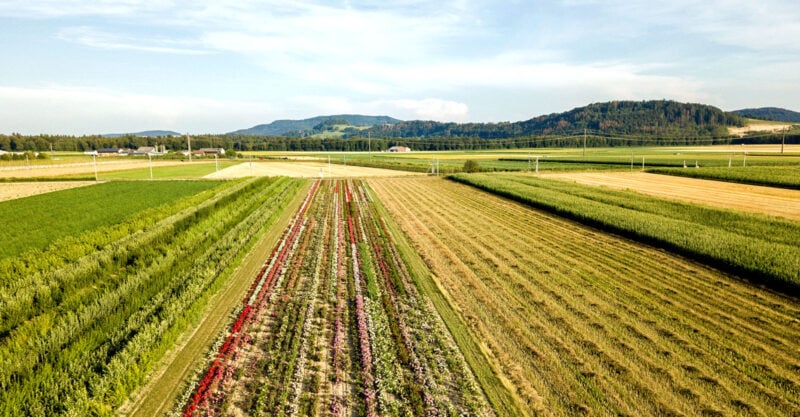‘Drop Monoculture and Industrial Thinking’: Study Shows Diversified Farming Pays Off for People and Planet
A new study of diverse agricultural operations worldwide found that farms and pastures can achieve significant social and environmental benefits by working “less like factories” and “more like healthy natural ecosystems.”
Story at a glance:
- Agricultural diversification may be the age-old “secret” to not only increase crop yields and improve food security but also protect the planet.
- Diversified agriculture had “win-win outcomes” for both society and the environment, according to data from 24 studies in 11 countries, spanning 2,655 farms.
- On farms using diversification strategies, social benefits, including human well-being, crop yields and food security, were noted, along with environmental gains, including improved biodiversity.
- The study revealed that livestock integration increases the amount of food the farm produces, reduces damage to soil and decreases environmental pollution.
- The benefits were greatest when multiple diversification strategies were used at once, and applied to all different types of farms.
Industrialized farming is characterized by monoculture, or growing one type of crop over a large area, season after season.
While said to be efficient and profitable, this oversimplification of farming systems comes with significant drawbacks that put human health and the environment at risk.
Diversification, on the other hand, may be the age-old “secret” to not only increase crop yields and improve food security but also protect the planet.
“If you look at how ecosystems operate, it’s not just plants growing alone. It’s not just animals or soil. It’s all of these things working together,” Zia Mehrabi, assistant professor of environmental studies at the University of Colorado Boulder, said in a news release.
Mehrabi and colleagues conducted a study showing that diversified agriculture had “win-win outcomes” for both society and the environment.
To put it simply, “Drop monoculture and industrial thinking and diversify the way you farm — it pays off,” said Laura Vang Rasmussen of the University of Copenhagen in Denmark, the study’s lead author.
Landmark study reveals major benefits of diversified agriculture
Using data from 24 studies in 11 countries, spanning 2,655 farms, the scientists revealed that five diversification strategies led to positive outcomes for people and the planet.
This includes:
- Livestock inclusion and diversification.
- Crop diversification, including crop rotation and cover crops.
- Soil conservation and fertility management, such as compost application.
- Noncrop plantings, including hedgerows.
- Water conservation, such as contour farming.
Contour farming, for instance, is an agricultural technique where crops are planted following the natural contours of the landscape rather than in straight lines.
This method is particularly useful on sloped land, as it helps reduce soil erosion by slowing runoff water and allowing it to soak into the ground rather than washing soil away.
By planting along the contours, farmers can create natural barriers that trap water and reduce the velocity of water moving across the surface.
Hedgerows, meanwhile, are lines of densely planted shrubs or trees that are commonly used as boundaries between different sections of land.
They’ve been used for centuries in agriculture, particularly in Europe, to mark property lines, contain livestock and provide windbreaks to protect crops.
In addition to improving biodiversity in agricultural landscapes by providing a variety of plant species and supporting different types of wildlife, hedgerows help to reduce agricultural runoff, filter pollutants and improve water quality in nearby streams and rivers.
Use of multiple diversification strategies led to the greatest benefits
On farms using diversification strategies, social benefits, including human well-being, crop yields and food security, were noted, along with environmental gains, including improved biodiversity.
The benefits were greatest when multiple diversification strategies were used at once, and applied to all different types of farms.
“The group discovered that farmers and ranchers can achieve many more benefits if they employ several agricultural solutions in tandem, rather than just one at a time,” the University of Colorado reported.
“For Mehrabi, the study reveals a new vision for food around the globe — one in which farms and pastures work less like factories for churning out calories and more like healthy natural ecosystems.”
What’s more, the study spanned agricultural operations across the globe, from small farms in rural Africa to plantation crops in Southeast Asia and large-scale farms in North America and Europe.
“The crazy thing is that the positive effect of adding multiple diversification practices is true across wildly different contexts,” Mehrabi said. “It works on industrial farms in the U.S. and in small-scale maize farms in Malawi.”
Half of the farms in the study, for instance, used some form of livestock integration, in which animals and crops are raised together within the same farming operation.
Benefits include nutrient recycling, as animal waste provides a rich source of organic fertilizer for the crops, enhancing soil fertility without the need for chemical fertilizers.
Livestock integration also provides a natural form of weed and pest control. Sheep and goats, for instance, can graze on weeds, and the grazing has an added benefit of improving soil structure and aeration.
The study revealed that livestock integration increases the amount of food the farm produces, reduces damage to soil and decreases environmental pollution.
As the University of Colorado noted:
“In many cases, Mehrabi said, more diverse farms can deliver extra benefits because they can better weather natural disasters like droughts or heat waves. In other cases, the positives are more subtle.
“If small-scale farmers grow fruit trees amid their crops, for example, they can eat those bananas or papayas themselves while selling the rest of the harvest.”
Green Revolution ushered in industrialized agriculture with negative effects
The Green Revolution that occurred between the 1940s and 1960s is heralded by increasing agricultural production worldwide.
However, it was instrumental in the implementation of industrialized agriculture, including genetic engineering, monocrops and increased use of synthetic fertilizers and pesticides.
Soil degradation, reduced soil fertility, pollution from chemical inputs and increased water use are all part of the Green Revolution’s legacy.
According to the featured study:
“Historically, the architects of the Green Revolution were primarily concerned with breeding crops and developing agronomic inputs to increase staple crop yields and respond to food security needs.
“However, the focus of their policies on simplifying agricultural systems came with unintended large and negative environmental impacts such as pollution, as well as social side effects such as farmer indebtedness, reduction of peoples’ dietary diversity, and reduced resilience.
“This has led to widespread calls for a change in agricultural development policy that addresses the negative side effects directly through the action of biologically diversified farming systems.”
The Corbett Report further explained why the so-called “Green” Revolution served to make oligarchs richer while threatening farmers and the environment:
“It was John D. Rockefeller III who, when sitting on the Board of Trustees of the Ford Foundation, convinced his fellow oligarchs to join the ‘Green Revolution’ by founding the Intensive Agriculture District Programme in India, which exacerbated the disparity between rich feudal landowners and poor farming peasants.
“And then of course there’s the Rockefeller’s work in Africa, which today takes the form of the Alliance for a Green Revolution in Africa [AGRA]. AGRA’s stated goal is to ‘elevate the single African voice’ on the world stage.
“It all sounds nice and fuzzy until you learn that 200 organizations have come together to denounce the alliance and its activities. They claim that the group has not only ‘unequivocally failed in its mission’ but has actually ‘harmed broader efforts to support African farmers.’”
AGRA, an organization funded by the Bill & Melinda Gates Foundation, was launched in 2006 with funding from the Gates Foundation and the Rockefeller Foundation.
It’s essentially a Gates Foundation subsidiary and most of its goals are centered on promoting biotechnology and chemical fertilizers.
After more than a decade, AGRA’s influence has significantly worsened the situation in the 18 African nations targeted by this “philanthropic” endeavor.
Hunger under AGRA’s direction increased by 30% and rural poverty rose dramatically.
During our interview, Robert F. Kennedy Jr. noted:
“He [Gates] got African countries to switch from traditional agriculture … to GMO [genetically modified organism] monocultures, with this idea that this is part of globalization that will bring big corporations in who will buy your products, give you cash and lift everybody’s standard of living up. That was the promise. But exactly the opposite happened. …
“It’s been an absolute calamity for the people of Africa. I think there’s 30 million additional people who have become food insecure as a direct result of Gates’ Green Revolution, but Gates and his companies have made a killing …
“In each philanthropical effort he makes, there’s always, at the end of it, some moneymaking scheme for Gates and his foundation.”
Living in concert with nature makes biodiversity thrive
Diversified agriculture depends on living in concert with nature and creating thriving, self-sustaining ecosystems.
Some farmers have also learned how to harness the natural environmental benefits of wildlife around them — even beavers, which are often mistakenly viewed as pests.
Centuries ago, about 200 million beavers maintained a “lush Eden of interlocking streams, creeks, ponds, lakes and rivers,” according to author Roberta Staley in Modern Farmer.
But as their animal pelts became prized for trading, their numbers dwindled — and so did their priceless gift to the environment.
Staley relates the story of Jon Griggs, manager of Maggie Creek Ranch in Elko, Nevada. The 200,000-acre ranch’s streams dried up after beavers were removed from the property for felling trees and blocking irrigation ditches.
Then, Griggs partnered with the Bureau of Land Management and beavers were reintroduced, restoring balance to the ecosystem not only on the ranch but on surrounding public lands.
“First, cattle’s access to creek beds during the spring and summer growing periods was restricted, allowing brush and grasses to regrow.
“As a result, creeks began widening, cooling and deepening. Willows took root, creating an ecosystem that could support beavers, which consume such woody species.
“Griggs watched as a new generation of Castor canadensis began to re-engineer the landscape by building dams, creating pools of water that preserved the snow melt and the dozen or so inches of annual rainfall.
“The moisture created green oases half a mile wide that emanated from the creeks. Grazing expanded. Cattle had more and better-quality drinking water. Trout flourished. The creeks flowed year-round.”
Staley also interviewed the owner of a 10,000-acre ranch that includes a national forest in Idaho. The area’s main source of water — Birch Creek — dried up but was restored when beavers were released.
Not only did the beavers restore a crucial water source for the ranch’s cattle, but they also led to an increase in other wildlife, including reptiles, waterfowl, insects and mammals.
It’s another powerful lesson on how embracing nature can solve many of the environmental challenges that modern-day farming created.
Overcoming barriers to diverse agriculture
The Science study acknowledged that financial and other barriers exist for many farmers interested in switching to more diverse agricultural practices.
Government subsidies exist, but they’re overwhelmingly geared toward support of industrialized programs at the expense of biodiversity and small farmers alike.
The University of Colorado explained:
“Governments already spend huge sums to buffer the agricultural industry. Some nations, for example, subsidize farmers so that they can grow water-intensive crops in areas that don’t get a lot of rain. That money might be better spent, Mehrabi said, in helping farmers diversify.”
Originally published by Mercola.
The views and opinions expressed in this article are those of the authors and do not necessarily reflect the views of Children’s Health Defense.
Suggest a correction





